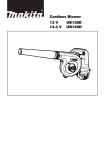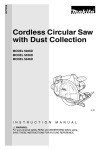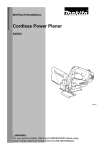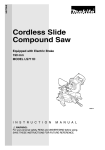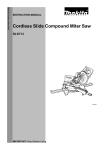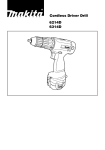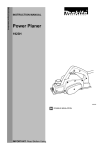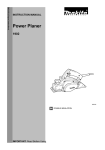Download Makita 1050D Specifications
Transcript
ENGLISH Cordless Power Planer MODEL 1050D 002540 I N S T R U C T I O N M A N U A L WARNING: For your personal safety, READ and UNDERSTAND before using. SAVE THESE INSTRUCTIONS FOR FUTURE REFERENCE. SPECIFICATIONS Model 1050D Planing width 50 mm Planing depth 0.5 mm Shiplapping depth 15 mm -1 No load speed (min ) 9,000 Overall length 293 mm Net weight 2.1 kg Rated voltage D.C.12V • Due to our continuing programme of research and development, the specifications herein are subject to change without notice. • Note: Specifications may differ from country to country. Intended use The tool is intended for planing wood. For European countries only Noise and Vibration The typical A-weighted sound pressure level is 72 dB (A). The noise level under working may exceed 85 dB (A). – Wear ear protection. – The typical weighted root mean square acceleration value is not more than 2.5 m/s2. EC-DECLARATION OF CONFORMITY We declare under our sole responsibility that this product is in compliance with the following standards of standardized documents, EN50260, EN55014 in accordance with Council Directives, 89/336/EEC, 98/37/EC. Yasuhiko Kanzaki CE 2003 Director MAKITA INTERNATIONAL EUROPE LTD. Michigan Drive, Tongwell, Milton Keynes, Bucks MK15 8JD, ENGLAND SAFETY INSTRUCTIONS ENA002-2 WARNING: When using battery operated tools basic safety precautions, including the following, should be followed to reduce the risk of fire, leaking batteries and personal injury: Read these instructions before operating this product and save these instructions. For safe operations: 1. Keep work area clean. Cluttered areas and benches invite injuries. 2. Consider the work environment. Do not expose the tool to rain. Keep work area well lit. Do not use tools in the presence of flammable liquids or gases. Keep children away. Do not let visitors touch the tool. Keep visitors away from work area. Store batteries or idle tools. When not in use, tools and batteries should be stored separately in a dry, high or locked up place, 3. 4. 2 5. 6. 7. out of reach of children. Ensure that battery terminals cannot be shorted by other metal parts such as screws, nails, etc. Do not force the tool. It will do the job better and safer at the rate for which it was intended. Use the right tool. Do not force small tools or attachments to do the job of a heavy duty tool. Do not use tools for purposes not intended. Dress properly. Do not wear loose clothing or jewellery, they can be caught in moving parts. Non-skid footwear is recom- 8. 9. 10. 11. 12. 13. 14. 15. 16. mended when working outdoors. Wear protecting hair covering to contain long hair. Use protective equipment. Use safety glasses and if the cutting operation is dusty, a face or dust mask. Connect dust extraction equipment. If devices are provided for the connection of dust extraction and collection ensure these are connected and properly used. Do not abuse the supply cord ( if fitted ). Never carry the tool by the cord or yank it to disconnect from the socket. Keep the cord away from heat, oil and sharp edges. Secure the work. Use clamps or a vice to hold the work. It is safer than using your hand and it frees both hands to operate the tool. Do not over-reach. Keep proper footing and balance at all times. Maintain tools with care. Keep cutting tools sharp and clean for better and safer performance. Follow instructions for lubrication and changing accessories. Inspect tool cords periodically and if damaged have repaired by an authorized service facility. Disconnect tools. Where the design permits, disconnect the tool from its battery pack when not in use, before servicing and when changing accessories such as blades, bits and cutters. Remove adjusting keys and wrenches. Form the habit of checking to see that keys and adjusting wrenches are removed from the tool before turning it on. Avoid unintentional starting. Do not carry the tool with a finger on the switch. 17. Stay alert. Watch what you are doing. Use common sense. Do not operate the tool when you are tired. 18. Check damaged parts. Before further use of the tool, a guard or other part that is damaged should be carefully checked to determine that it will operate properly and perform its intended function. Check for alignment of moving parts, free running of moving parts, breakage of parts, mounting and any other condition that may affect its operation. A guard or other part that is damaged should be properly repaired or replaced by an authorized service facility unless otherwise indicated in this instruction manual. Have defective switches replaced by an authorized service facility. Do not use the tool if the switch does not turn it on and off. 19. Warning. The use of any accessory or attachment, other than recommended in this instruction manual or the catalog, may present a risk of personal injury. Ensure that the battery pack is correct for the tool. Ensure that the outside surface of battery pack or tool is clean and dry before plugging into charger. Ensure that batteries are charged using the correct charger recommended by the manufacturer. Incorrect use may result in a risk of electric shock, overheating or leakage of corrosive liquid from the battery. 20. Have your tool repaired by a qualified person. This tool is constructed in accordance with the relevant safety requirements. Repairs should only be carried out by qualified persons using original spare parts, otherwise this may result in considerable danger to the user. 21. Disposal of battery. Ensure battery is disposed of safely as instructed by the manufacturer. ADDITIONAL SAFETY RULES FOR TOOL 1. Be aware that this tool is always in an operating condition, because it does not have to be plugged into an electrical outlet. 2. Rags, cloth, cord, string and the like should never be left around the work area. 3. Avoid cutting nails. Inspect for and remove all nails from the workpiece before operation. 4. Use only sharp blades. Handle the blades very carefully. 5. Be sure the blade installation bolts are securely tightened before operation. 6. Hold the tool firmly with both hands. 7. Keep hands away from rotating parts. ENB043-1 8. Before using the tool on an actual workpiece, let it run for a while. Watch for vibration or wobbling that could indicate poor installation or a poorly balanced blade. 9. Make sure the blade is not contacting the workpiece before the switch is turned on. 10. Wait until the blade attains full speed before cutting. 11. Keep at least 200 mm away from the tool at all times. 12. Always switch off and wait for the blades to come to a complete stop before any adjusting. 3 13. Never stick your finger into the chip chute. Chute may jam when cutting damp wood. Clean out chips with a stick. 16. Always change both blades or covers on the drum, otherwise the resulting imbalance will cause vibration and shorten tool life. 14. Do not leave the tool running. Operate the tool only when hand-held. 17. Wait for complete run-down before putting the tool aside. 15. When leaving the planer, switch off and set it with the front base up on a wooden block, so that the blades do not contact anything. 18. Use only Makita blades specified in this manual. SAVE THESE INSTRUCTIONS IMPORTANT SAFETY INSTRUCTIONS FOR BATTERY CARTRIDGE 1. Do not disassemble battery cartridge. 3. If operating time has become excessively shorter, stop operating immediately. It may result in a risk of overheating, possible burns and even an explosion. 4. 5. 6. (1) Do not touch the terminals with any conductive material. Before using battery cartridge, read all instructions and cautionary markings on (1) battery charger, (2) battery, and (3) product using battery. 2. ENC004-1 (2) Avoid storing battery cartridge in a container with other metal objects such as nails, coins, etc. (3) Do not expose battery cartridge to water or rain. A battery short can cause a large current flow, overheating, possible burns and even a breakdown. If electrolyte gets into your eyes, rinse them out with clear water and seek medical attention right away. It may result in loss of your eyesight. 7. Always cover the battery terminals with the battery cover when the battery cartridge is not used. Do not store the tool and battery cartridge in locations where the temperature may reach or exceed 50°C (122°F). 8. Do not incinerate the battery cartridge even if it is severely damaged or is completely worn out. The battery cartridge can explode in a fire. 9. Be careful not to drop or strike battery. Do not short the battery cartridge: SAVE THESE INSTRUCTIONS Tips for maintaining maximum battery life 1. Charge the battery cartridge before completely discharged. Always stop tool operation and charge the battery cartridge when you notice less tool power. 2. Never recharge a fully charged battery cartridge. Overcharging shortens the battery service life. 4 3. Charge the battery cartridge with room temperature at 10°C - 40°C (50°F - 104°F). Let a hot battery cartridge cool down before charging it. 4. Charge the Nickel Metal Hydride battery cartridge when you do not use it for more than six months. FUNCTIONAL DESCRIPTION • 002544 Installing or removing battery cartridge • 1 2 • • • 1. Button 2. Battery cartridge 002547 2 1 CAUTION: Always be sure that the tool is switched off and the battery cartridge is removed before adjusting or checking function on the tool. Always switch off the tool before insertion or removal of the battery cartridge. To remove the battery cartridge, withdraw it from the tool while pressing the buttons on both sides of the cartridge. To insert the battery cartridge, align the tongue on the battery cartridge with the groove in the housing and slip it into place. Always insert it all the way until it locks in place with a little click. If not, it may accidentally fall out of the tool, causing injury to you or someone around you. Do not use force when inserting the battery cartridge. If the cartridge does not slide in easily, it is not being inserted correctly. Adjusting depth of cut The depth of cut can be adjusted in 0.1 mm increments within a range of 0 - 0.5 mm. Turn the knob on the front of the tool until the pointer is aligned with the desired cutting depth on the scale. 3 • CAUTION: The knob can be turned beyond the 0.5 mm graduation. However, do not operate the tool with a depth of cut more than 0.5 mm The motor may be burned out or the battery cartridge may be damaged. 1. Pointer 2. Scale 3. Knob 002551 1 Switch action CAUTION: Before inserting the battery cartridge into the tool, always check to see that the switch trigger actuates properly and returns to the “OFF” position when released. To prevent the switch trigger from being accidentally pulled, a lock-off button is provided. To start the tool, depress the lock-off button and pull the switch trigger. Release the switch trigger to stop. • 2 1. Lock-off button 2. Switch trigger 5 ASSEMBLY • CAUTION: Always be sure that the tool is switched off and the battery cartridge is removed before carrying out any work on the tool. Removing or installing planer blades • • • CAUTION: Tighten the blade installation bolts carefully when attaching the blades to the tool. A loose installation bolt can be dangerous. Always check to see they are tightened securely. Handle the blades very carefully. Use gloves or rags to protect your fingers or hands when removing or installing the blades. Use only the Makita wrench provided to remove or install the blades. Failure to do so may result in overtightening or insufficient tightening of the installation bolts. This could cause an injury. 002557 To remove the blades, first loosen the two installation bolts one turn counterclockwise with the hex wrench. 002558 Push the blade from the belt side with the hex wrench. Remove the other blade in the same manner. 1 2 1. Installation bolts 2. Hex wrench 1 2 1. Hex wrench 2. Planer blade 002559 1 2 3 4 1. 2. 3. 4. 5. 6 5 Drum cover Installation bolts Planer blade Side of drum Drum To install the blades, first clean out all chips or foreign matter adhering to the drum or blades. Insert the blade between the drum and the drum cover from the side opposite the belt so that the blade end will protrude slightly from the side of the drum. Tighten the two installation bolts securely with the hex wrench. 002567 Blade height adjustment Blade height adjustment is usually not necessary. However, if you notice that the blade edge is below the level of the rear base or protrudes too far from the rear base, proceed as follows. Loosen the two installation bolts. Turn the pan head screws clockwise to retract the blade or counterclockwise to protrude it. After adjusting the blade height, tighten the two installation bolts securely. 1 2 1. Pan head screws 2. Installation bolts 002568 Hex wrench storage When not in use, store the hex wrench as shown in the figure to keep it from being lost. 1 1. Hex wrench 002572 Dust bag Install the dust bag on the nozzle of the tool. When installing it, push the bag’s entry port toward the nozzle as far as it will go to prevent it from coming off during operation. For the best results, empty the dust bag when it becomes about half full. Remove the dust bag from the tool and pull out the fastener. 2 1 NOTE: 3 • 1. Dust bag 2. Nozzle 3. Fastener 002573 1 Edge fence (Guide rule) Use the edge fence when shiplapping (rabbeting) or cutting workpieces nearly 50 mm wide. Install the edge fence on the tool and secure it with the washer and thumb screw (A). Loosen the thumb screw (B) and adjust the edge fence until it comes in contact with the side of the workpiece. Then tighten the thumb screw (B) securely. 2 4 1. 2. 3. 4. If you connect a Makita vacuum cleaner to this tool, more efficient and cleaner operations can be performed. 3 Thumb screw (A) Washer Edge fence Thumb screw (B) 7 002574 You may wish to add to the length of the fence by attaching an extra piece of wood. Convenient holes are provided in the fence for this purpose. 002576 Planing operation OPERATION 2 1 1. Start 2. End 002580 First, rest the tool front base flat upon the workpiece surface without the blades making any contact. Switch on and wait until the blades attain full speed. Then move the tool gently forward. Apply pressure on the front of tool at the start of planing, and at the back at the end of planing. Planing will be easier if you incline the workpiece in stationary fashion, so that you can plane somewhat downhill. The speed and depth of cut determine the kind of finish. The power planer keeps cutting at a speed that will not result in jamming by chips. For rough cutting, the depth of cut can be increased, while for a good finish you should reduce the depth of cut and advance the tool more slowly. Shiplapping (Rabbeting) To make a stepped cut as shown in the figure, use the edge fence (guide rule). 002581 3 Draw a cutting line on the workpiece. Align the blade edge with the cutting line. Then adjust the edge fence as explained in the “Edge fence” section. When planing, move the tool with the edge fence flush with the side of the workpiece. Otherwise uneven planing may result. Maximum shiplapping (rabbeting) depth is 15 mm. • 1 2 1. Blade edge 2. Side of drum 3. Cutting line 8 CAUTION: Before shiplapping, adjust the blade so that the end protrudes slightly from the side of the drum. 002585 5.6 mm (7/32 ) 5.6 mm (7/32 ) Chamfering To make a chamfering cut as shown in the figure, align the “V” groove in the front base with the edge of the workpiece and plane it. It chamfers up to 5.6 mm in a single pass. 002586 1 1. “V”groove MAINTENANCE CAUTION: Always be sure that the tool is switched off and the battery cartridge is removed before attempting to perform inspection or maintenance. To maintain product SAFETY and RELIABILITY, repairs, any other maintenance or adjustment should be performed by Makita Authorized Service Centers, always using Makita replacement parts. • ACCESSORIES CAUTION: These accessories or attachments are recommended for use with your Makita tool specified in this manual. The use of any other accessories or attachments might present a risk of injury to persons. Only use accessory or attachment for its stated purpose. If you need any assistance for more details regarding these accessories, ask your local Makita service center. • • • Mini planer blade Dust bag • Various type of Makita genuine batteries and chargers 9 Memo 10 Memo 11 Makita Corporation 884218B225












